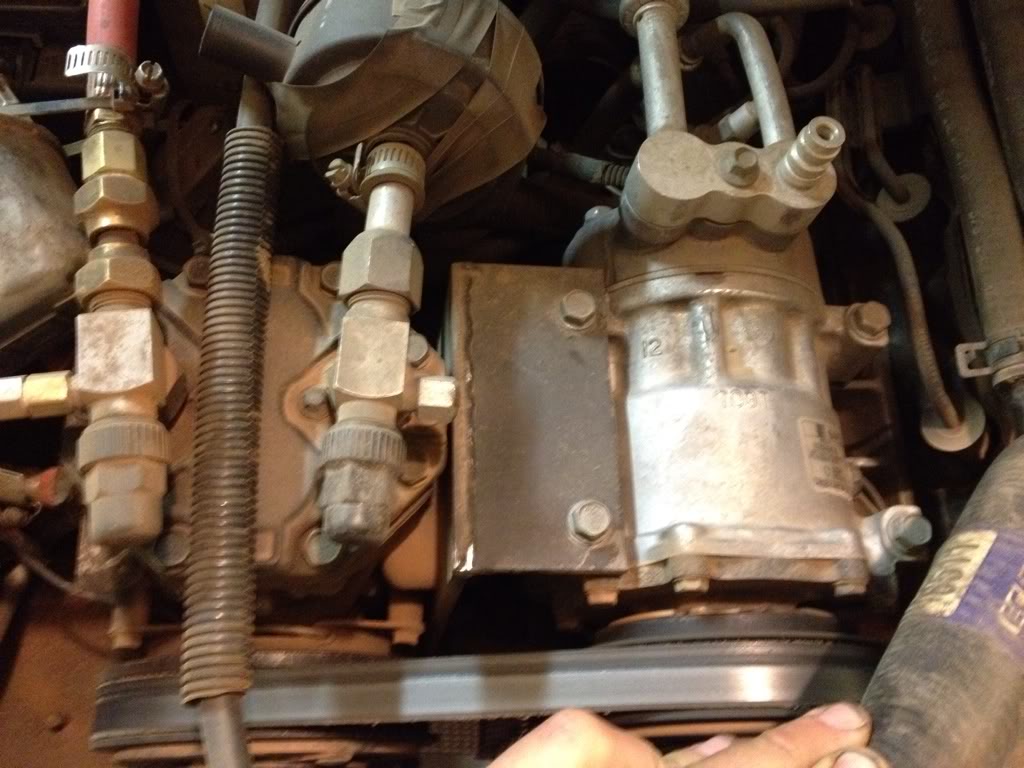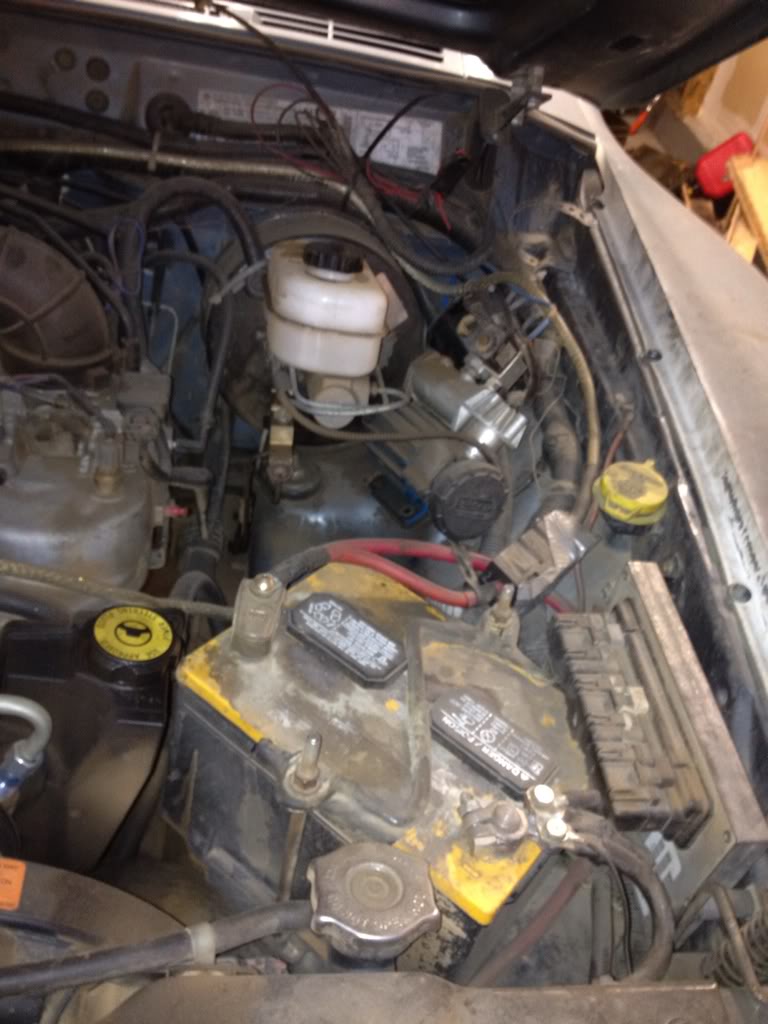battery relocation?
#2
Newbie
Join Date: Jan 2012
Location: Lethbridge Alberta
Posts: 21
Likes: 0
Received 0 Likes
on
0 Posts
Year: 1998
Model: Cherokee
Engine: 4.0l I6
The point of running two batteries is that it takes less strain off the alternator when running high load accessories like lights or a winch. You can also isolate one battery to use only for starting so that you are never left with a dead jeep. Hope this helps.
#3
CF Veteran
Join Date: May 2008
Posts: 3,018
Likes: 0
Received 13 Likes
on
13 Posts
Year: 1988
Model: Cherokee
Engine: AMC242
Relocation of batteries is often done on road vehicles to improve weight distribution, and therefore handling, to some small degree.
Getting the battery out of the engine bay - and therefore heat - can also help to improve longevity (the battery is a chemical device, and most chemical reactions are adversely affected by heat.)
Also, relocation of the battery (in most cases) can allow a larger battery to be fitted - which can allow for increased reserve electrical capacity.
Mounting a secondary battery (typically either a single deep cycle or a number of DC batteries in a parallel-wired bank) is often done to allow for extended "engine OFF" electrical operation - inverters, appliances, stereos, and suchlike can be run with the engine off, and having isolated the starting battery, you'll still be able to start the engine when you want to go home.
Secondary batteries are also installed to make up for very high current loads from devices, even with the engine ON. Yes, audio competitors tend to mount extra batteries (and alternators!) but I've more often seen it on emergency response vehicles and SAR rigs - emergency response vehicles have plenty of radios and lights, as well as computers and, in many cases, medical gear. Fire trucks also have to run additional pumps and suchlike.
SAR rigs have a much higher anticipated duty cycle in their winches - and rather larger winches, with correspondingly higher draws. Yes, PTO winches are often used (and therefore powered directly by the mechanical output of the engine,) but a PTO is only useful with the engine running, and is a pain to move. An electric winch can be rapidly relocated to anywhere there is a mounting hardpoint and an electrical supply point - which can be preconfigured when the vehicle is built, and this would allow reconfiguration in the field in a minute or less.
The typical hobbyist/enthusiast might have an anticipated duty cycle for their winch of ~5% WRT engine runtime, and would probably be running a winch rated for 8,000-10,000lb-f (the thumb rule is roughly twice the vehicles "wet, loaded" kerb weight.)
I've wired SAR rigs with purpose-built 18,000lb-f and 20,000lb-f winches (no, you're not going to find them. Easily...) that have a full-weight, first-layer current demand of upwards of 1,000A! And, with an anticipated duty cycle WRT engine runtime of 20-25%. You pretty much have to wire up a deep cycle bank of 3 or 4 batteries to get more than a ten-foot pull off of that, and two or three high-output alternators coupled with a "fast idle" switch can nearly be considered mandatory as well (running three high-output alternators will net you about half of the current needed to feed the winch - the rest comes from the deep cycle bank.)
Most people really don't require secondary batteries, they'd be better served using a higher-output alternator (and would spend less money overall, once it's done.) I can help you decide whether or not you would be better off spending your money on secondary battery(ies), isolator, and cabling - or just getting a better alternator - if you would like. Let me know!
Getting the battery out of the engine bay - and therefore heat - can also help to improve longevity (the battery is a chemical device, and most chemical reactions are adversely affected by heat.)
Also, relocation of the battery (in most cases) can allow a larger battery to be fitted - which can allow for increased reserve electrical capacity.
Mounting a secondary battery (typically either a single deep cycle or a number of DC batteries in a parallel-wired bank) is often done to allow for extended "engine OFF" electrical operation - inverters, appliances, stereos, and suchlike can be run with the engine off, and having isolated the starting battery, you'll still be able to start the engine when you want to go home.
Secondary batteries are also installed to make up for very high current loads from devices, even with the engine ON. Yes, audio competitors tend to mount extra batteries (and alternators!) but I've more often seen it on emergency response vehicles and SAR rigs - emergency response vehicles have plenty of radios and lights, as well as computers and, in many cases, medical gear. Fire trucks also have to run additional pumps and suchlike.
SAR rigs have a much higher anticipated duty cycle in their winches - and rather larger winches, with correspondingly higher draws. Yes, PTO winches are often used (and therefore powered directly by the mechanical output of the engine,) but a PTO is only useful with the engine running, and is a pain to move. An electric winch can be rapidly relocated to anywhere there is a mounting hardpoint and an electrical supply point - which can be preconfigured when the vehicle is built, and this would allow reconfiguration in the field in a minute or less.
The typical hobbyist/enthusiast might have an anticipated duty cycle for their winch of ~5% WRT engine runtime, and would probably be running a winch rated for 8,000-10,000lb-f (the thumb rule is roughly twice the vehicles "wet, loaded" kerb weight.)
I've wired SAR rigs with purpose-built 18,000lb-f and 20,000lb-f winches (no, you're not going to find them. Easily...) that have a full-weight, first-layer current demand of upwards of 1,000A! And, with an anticipated duty cycle WRT engine runtime of 20-25%. You pretty much have to wire up a deep cycle bank of 3 or 4 batteries to get more than a ten-foot pull off of that, and two or three high-output alternators coupled with a "fast idle" switch can nearly be considered mandatory as well (running three high-output alternators will net you about half of the current needed to feed the winch - the rest comes from the deep cycle bank.)
Most people really don't require secondary batteries, they'd be better served using a higher-output alternator (and would spend less money overall, once it's done.) I can help you decide whether or not you would be better off spending your money on secondary battery(ies), isolator, and cabling - or just getting a better alternator - if you would like. Let me know!
#6
Senior Member
Join Date: Mar 2012
Location: Bellevue, WA
Posts: 512
Likes: 0
Received 1 Like
on
1 Post
Year: 1998
Model: Cherokee
Engine: 4.0L
Us normal SAR folks use 8K to 12K winches, on a variety of vehicles and get along pretty well with two Optimas, connected through an isolator with an option switch. For our larger rigs, we use two Odisseys with larger capacity. When we need more pulling power, we use ****** blocks...
#7
CF Veteran
Join Date: May 2008
Posts: 3,018
Likes: 0
Received 13 Likes
on
13 Posts
Year: 1988
Model: Cherokee
Engine: AMC242
SAR rigs typically need more power with and without engine running, to feed the winch, radios and lights. I was amazed to read about the gentleman above with the multiple batteries and 20K winches. If you need a 20K winch on a rescue, you have bigger problems.
Us normal SAR folks use 8K to 12K winches, on a variety of vehicles and get along pretty well with two Optimas, connected through an isolator with an option switch. For our larger rigs, we use two Odisseys with larger capacity. When we need more pulling power, we use ****** blocks...
Us normal SAR folks use 8K to 12K winches, on a variety of vehicles and get along pretty well with two Optimas, connected through an isolator with an option switch. For our larger rigs, we use two Odisseys with larger capacity. When we need more pulling power, we use ****** blocks...
Therefore, having a stronger winch in the first place can be a huge advantage when you really need it...
Thread
Thread Starter
Forum
Replies
Last Post
sluger17
Stock XJ Cherokee Tech. All XJ Non-modified/stock questions go here
9
07-08-2023 07:08 AM
SergeK
Stock XJ Cherokee Tech. All XJ Non-modified/stock questions go here
8
02-27-2023 03:38 PM
Cherokee_of_Tennessee
Stock XJ Cherokee Tech. All XJ Non-modified/stock questions go here
4
09-30-2015 12:10 PM
chrispl57
Stock XJ Cherokee Tech. All XJ Non-modified/stock questions go here
11
09-30-2015 08:13 AM
Currently Active Users Viewing This Thread: 1 (0 members and 1 guests)






